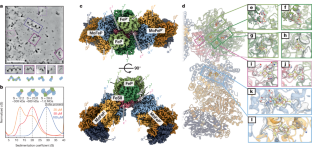2025-01-08 カリフォルニア大学サンディエゴ校
<関連情報>
- https://today.ucsd.edu/story/how-diazotrophs-fix-nitrogen
- https://www.nature.com/articles/s41586-024-08311-1
ニトロゲナーゼが酸素から保護される構造的基盤 Structural basis for the conformational protection of nitrogenase from O2
Sarah M. Narehood,Brian D. Cook,Suppachai Srisantitham,Vanessa H. Eng,Angela A. Shiau,Kelly L. McGuire,R. David Britt,Mark A. Herzik Jr & F. Akif Tezcan
Nature Published:08 January 2025
DOI:https://doi.org/10.1038/s41586-024-08311-1

Abstract
The low reduction potentials required for the reduction of dinitrogen (N2) render metal-based nitrogen-fixation catalysts vulnerable to irreversible damage by dioxygen (O2)1,2,3. Such O2 sensitivity represents a major conundrum for the enzyme nitrogenase, as a large fraction of nitrogen-fixing organisms are either obligate aerobes or closely associated with O2-respiring organisms to support the high energy demand of catalytic N2 reduction4. To counter O2 damage to nitrogenase, diazotrophs use O2 scavengers, exploit compartmentalization or maintain high respiration rates to minimize intracellular O2 concentrations4,5,6,7,8. A last line of damage control is provided by the ‘conformational protection’ mechanism9, in which a [2Fe:2S] ferredoxin-family protein termed FeSII (ref. 10) is activated under O2 stress to form an O2-resistant complex with the nitrogenase component proteins11,12. Despite previous insights, the molecular basis for the conformational O2 protection of nitrogenase and the mechanism of FeSII activation are not understood. Here we report the structural characterization of the Azotobacter vinelandii FeSII–nitrogenase complex by cryo-electron microscopy. Our studies reveal a core complex consisting of two molybdenum–iron proteins (MoFePs), two iron proteins (FePs) and one FeSII homodimer, which polymerize into extended filaments. In this three-protein complex, FeSII mediates an extensive network of interactions with MoFeP and FeP to position their iron–sulphur clusters in catalytically inactive but O2-protected states. The architecture of the FeSII–nitrogenase complex is confirmed by solution studies, which further indicate that the activation of FeSII involves an oxidation-induced conformational change.


00224-3/asset/9bd2e67c-abfd-46a1-9640-974ed303cc2d/main.assets/gr1.jpg)